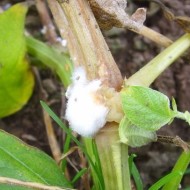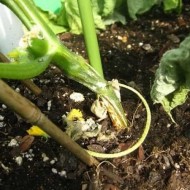How to grow cucumber Herman F1 in a greenhouse and in the beds
Content
The history of the emergence of a hybrid
Herman F1 – foreign guest. It was developed by Dutch breeders from Monsanto Holland in the second half of the 20th century. The hybrid variety quickly gained acceptance by farmers in Europe and the United States. At the beginning of the XXI century, it was officially recommended for cultivation in vegetable gardens and farms in Russia.
Description and characteristics of the variety
German F1 can be grown in greenhouses, greenhouses and outdoors. They mature quickly and do not require pollination.
Description of the bush
Cucumber bushes grow strong and powerful. Their appearance is not spoiled by strong winds or rainstorms. Shoots are easily braided on supports and trellises.
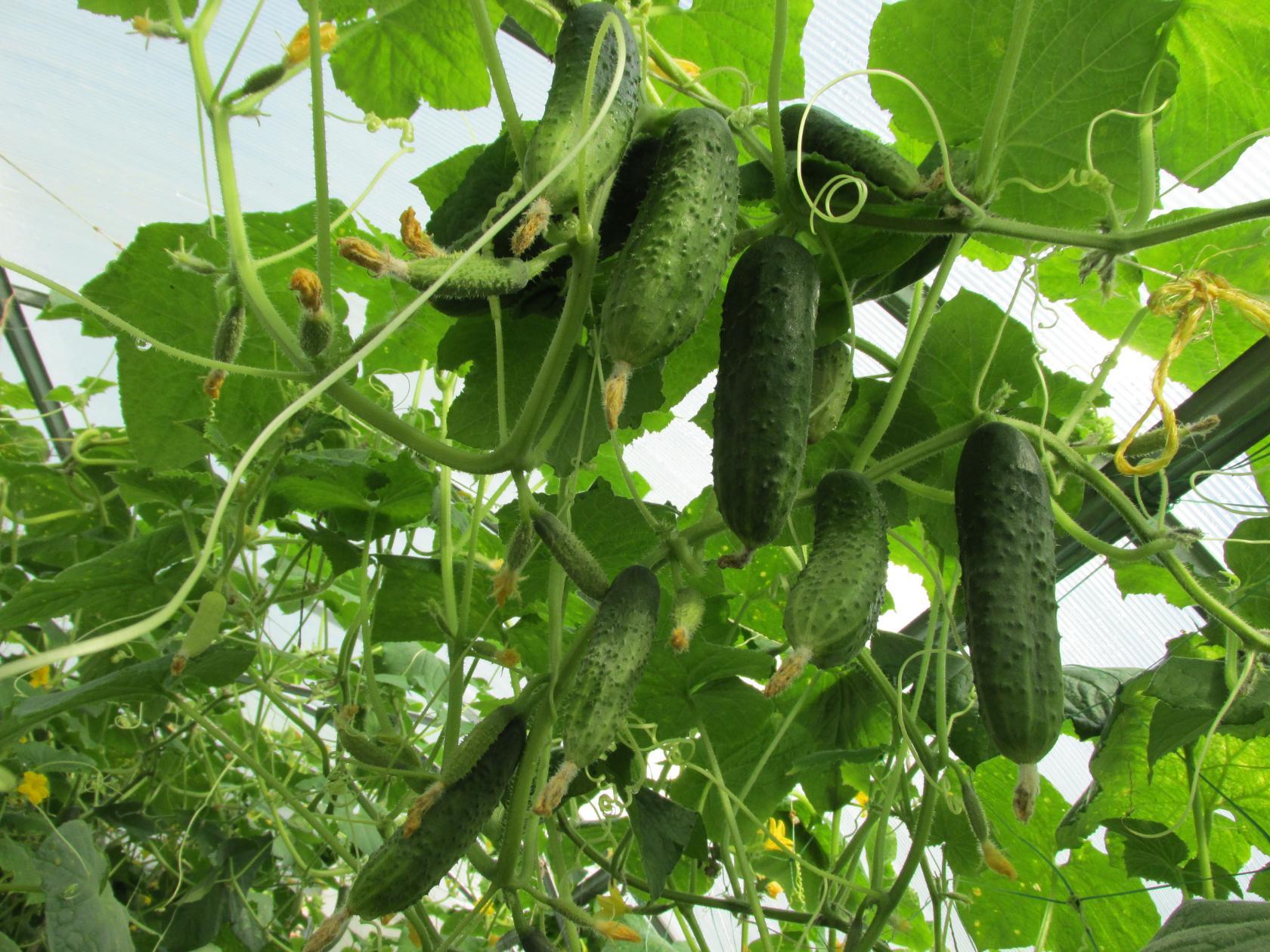
Their height reaches 4–5 m. Young branches are easy to form and can grow not in length, but in breadth. This makes the harvesting process easier. They also do not bend or break under the weight of ripe fruits.
Taste and commercial qualities of fruits
Gardeners who grow cucumbers for sale note that most of the fruits have an attractive presentation. They are elongated, have a regular cylinder shape, rounded at the ends. Small fruit size – 8–10 cm.Their mass can reach 100 g.
Cucumbers rarely have defects and deformations, so they are good for sale. The taste is characteristic, fresh, crunchy, without bitter aftertaste.
Yield
Each lash on the lash gives 7–8 fruits. Taking into account the length of the shoot and the number of branches on one bush, these indicators are considered a sign of high yields. From 1 m of the garden during the first harvest, you can harvest 10–15 kg of cucumbers.
Collection, storage and use of the crop
Harvest ripening begins in 35–38 days after planting seedlings in the ground. At this time, the first cucumbers appear. After another 8–9 days fruiting becomes massive. At this time, you can start collecting for sale or conservation.
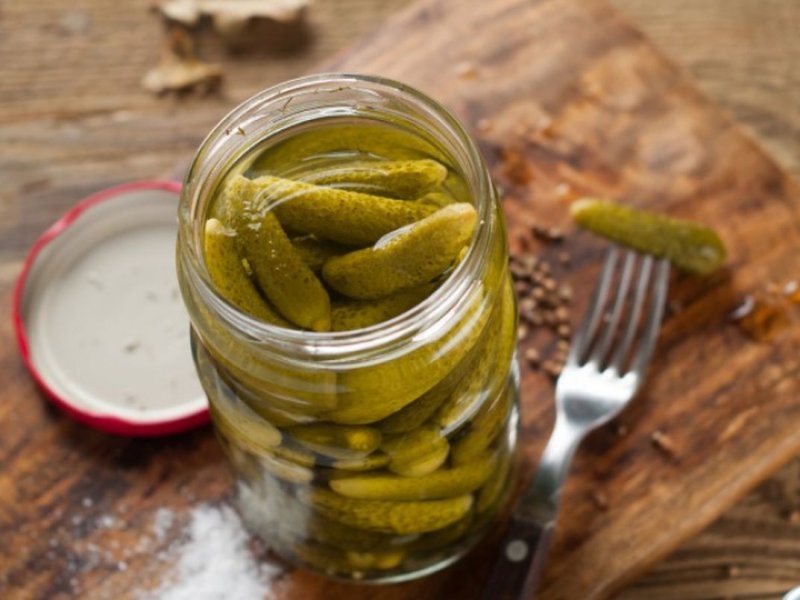
The fruits are easily separated from the whip, so the risk of damaging the bush during picking is minimal. The harvest is stored well, the harvested cucumbers can lie in the refrigerator without losing their presentation 5–7 days. The taste of the fruit allows it to be used in fresh salads. Due to the absence of bitterness, the taste of the finished product will not deteriorate.
The small size is ideal for canning.
Cucumbers fit easily into a jar, do not lose their shape and retain their pleasant taste even after heat treatment.
The canned product can be stored for up to 3 years.
Video «Hybrid variety German F1»
From this video you will learn about some of the features of growing cucumbers of this variety.
Advantages and disadvantages
- small fruit size and favorable presentation;
- lack of bitterness and good taste characteristics of the fruit;
- minimal risk of yellowing and overgrowing;
- long shelf life;
- self-pollination and independence of the crop from weather conditions;
- high speed of germination and maturation;
- resistance to many diseases;
- powerful bushes that are not subject to mechanical damage.
- plant vulnerability at the seedling stage;
- frost intolerance;
- susceptibility to rust disease.
Features of planting and growing a hybrid form
Hybrid German F1, with proper care, gives a good harvest and does not get sick. The recommendations developed by breeders and experienced gardeners should be adhered to.
Sowing seedlings
For growing seedlings, disposable cups are used. Each seed is grown in a separate container. To grow healthy seedlings, you need to make sure the quality of the seeds. They must be colored and have the same shape. External damage, points, cracks should be absent.

The planting material is immersed in a saline solution for 20 minutes. Quality seeds will remain at the bottom. After sorting, they are immersed in the nutrient soil to a depth of 8–10 mm and sprinkled with earth.
During germination, the soil in the container must not be allowed to dry out. After sprouting, water the seedlings carefully so that the flow of water does not damage the fragile stems.
As a rule, germination rate is 95–98%. In open ground, seedlings are planted after 25–30 days when 4 appears on it–5 leaves.
Outdoor cultivation
Planting seeds in open ground is practiced mainly in the south and in regions with a warm climate. For seedlings to survive, the night temperature must not fall below 8–10 ° C, and during the day the air should warm up to no less than 18 ° C. In warm areas, planting is carried out in May, in central Russia – in the middle or at the end of June.
Before planting, the soil must be loosened and mixed with rotten leaves or sawdust. This will increase the saturation level of the soil with air. In the cultivated soil, holes or grooves are made in which the seeds are placed. The distance between them should be 30–35 cm. Between rows it is better to leave up to 80 cm to facilitate harvesting.

Peat and nitrogen fertilizers are applied to the planting recesses. After that, they should be moistened. After planting, the seeds are sprinkled with earth a little and covered with a film or a sufficient layer of mulch.
Watering, loosening and hilling
Timely hydration helps to increase yields. In cloudy weather, it is enough to water them every 4–5 days. In heat and drought, the frequency of watering is increased to 3–4 times a week. Watering is carried out in the evening so that water does not fall on the leaves.
Once a week, you need to loosen the aisles and remove weeds from them. This contributes to the saturation of the soil with oxygen and the supply of nutrients to the roots. But during this procedure, the tool must not be deepened more than 4–5 cm. Cucumbers have roots near the surface and garden tools can harm them.
To form an additional root system, the bushes can be spud. This will provide additional nutrition and health benefits for the plant.
Forming a whip
The formation of the lash by pruning and pinching is done to increase the yield of the bush and facilitate harvesting. The ovary is removed in the sinuses up to 5–6 leaves. Next, 1–2 ovaries and remove shoots. When the lash grows to 150 cm, the top is pinched so that the bush does not stretch out.
After forming, the cucumbers should be watered regularly so that they can recuperate after the procedure.It should take 10–12 liters of water.
Fertilization and feeding
Fertilizing cucumbers is divided into three main stages. The first feeding is done after 2–3 weeks after emergence, when 3–4 adult leaves. At this time, nitroammofoska is introduced in a proportion of 10 g per 5 liters of water. When the plants bloom and the first ovaries appear, they are fed with potassium sulfate in a ratio of 1 g per 1 liter of water. During fruiting, once a week, cucumbers are watered with various mineral fertilizers.
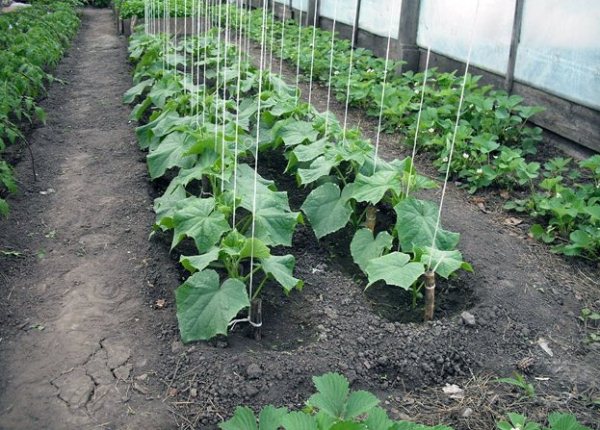
Hybrid cucumber variety German F1 is able to give a second harvest, which will ripen in mid-August. From 1 m of the garden you can collect another 5–8 kg of cucumbers. To do this, you can use the foliar feeding method. Once every 10 days, in the evenings, the plants are sprayed with a solution of milk or whey and iodine. Add 35 drops of the substance to a liter of liquid and mix thoroughly. Some replace iodine with boric acid, and milk – boiled water. Also, the second wave of the harvest is facilitated by the removal of yellowed leaves.
Prevention of diseases and pests
Herman F1 is susceptible to a disease such as rust. When this disease is affected, a light bloom appears on the leaves, the lashes are bent, the fruits are deformed. The ovary develops poorly. To fight and preserve the harvest, the affected shoots are removed and burned, and healthy areas are treated with Arcerid or Topaz preparations. So that the disease does not return next year, in the fall, the beds are dug deeply.
Root rot can also destroy the crop. The shoots near the roots turn dark brown, the lower leaves turn yellow. The plant withers quickly. They need to be sprayed with a weak solution of bleach and watered abundantly.
If a white rotting bloom appears on the whips and leaves, then they are affected by white rot. The leaves wither, the stems are covered with black dots. The diseased parts of the plants are cut off, the healthy ones are treated with copper sulfate.
Reviews of gardeners
Gardeners who grow a hybrid of this variety speak well of its taste and yield.
The Dutch hybrid German F1 received recognition from domestic gardeners due to its early ripening, high yield and pleasant taste of the fruit. It can be used in cooking for salads and canning for the winter. And growing for sale will allow you to get significant profits.


